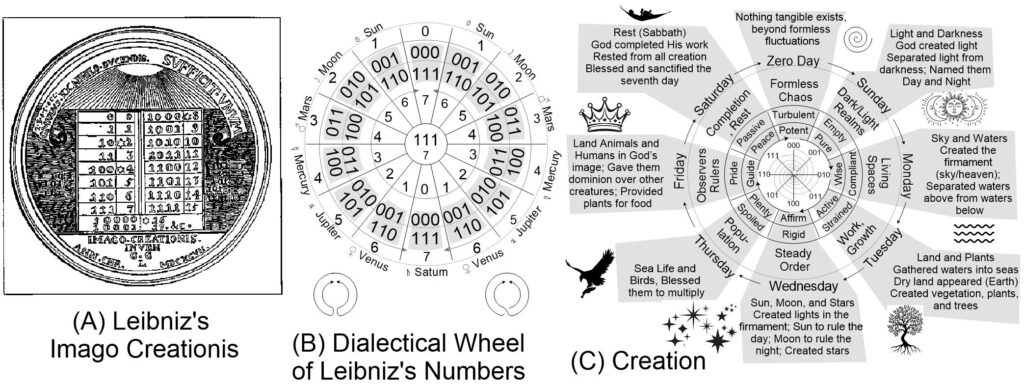Can artificial intelligence ever achieve deep spiritual insight? We argue it cannot, building on considerations of Landgrebe & Smith (2022). Leibniz’s binary code offers a fascinating window into this problem.
Back in 17th century Leibniz argued that all numbers could be created from 1 and 0, just as God created everything from nothing, presenting his idea in ‘Imago Creationis’ (Fig. A).

Leibniz saw a pattern that could explain how order emerges from chaos – mirroring idea of how wisdom can be decentralized yet structured. Our framework uncovers this pattern through the dialectic wheels in Figs. B and C. While machines can master each wheel separately, their conjunction creates a synthesis beyond formal logic – a domain where spiritual understanding thrives and machines cannot follow.
The Double-Loop
The first wheel (Fig. B) represents dialectical relations among binary numbers based on the following requirements:
- Numbers must follow natural progression (0, 1, 2, …)
- Numbers with inverse digits (like 000/111 or 001/110) must be placed diagonally opposite each other – an essential requirement of self-regulating system, enabling synchronization and mutual enhancement into higher synthesis, just as opposite qualities merge to create new level of existence
- When facing its opposite, each number can either move toward synthesis or toward separation. This fundamental choice requires a double-loop structure where each binary number faces its inverse diagonally while maintaining sequential order, resembling quantum bits that exist simultaneously as 0 and 1.
The sum of oppositions is always constant (111), revealing a simple principle: the best we can achieve is unity with opposition (move to the center of the wheel), while the worst we can achieve is become identical to what we oppose (move to the outer circle).
This is the whole point of decentralized wisdom: fighting the opponent makes you like an opponent => leads to chaos, while fighting own temptations creates order out of chaos. The similar but inverse logic is also used in computer operators (0 AND 1 => 0, 0 OR 1 => 1).
The same pattern also unites microscopic and cosmic scales, shown through connection of digits to the ancient cycles of planetary week (7 days) and lunar month (4 weeks).
The Wisdom Cycle
The second wheel (Fig. C) transforms binary patterns into a framework for wisdom. Each number represents a stage in creation, from primal chaos (000 = Day 0) to final completion (111 = Day 7), forming four pairs of dialectical oppositions.
Unlike the first wheel’s mechanical certainty, here we discover how binary oppositions can guide decision-making. The inner circle shows positive aspects of each stage, opposing negative aspects in the outer circle – for example, the Potency of Formless Chaos (Day 0) opposes the Rigidity of Steady Order (Day 4).
While binary oppositions always sum to 111, spiritual synthesis varies with direction and starting point. Positive synthesis flows clockwise: a positive aspect influences both its diagonal opposite and clockwise neighbor. Starting with Day 0’s Potency, it awakens both Day 4’s Affirmation and Day 1’s Purity, creating an upward spiral of increasing harmony.
Negative synthesis moves counterclockwise, against universal order. Though quicker to achieve, its results are less stable than positive synthesis. (See Dialectical Ethics for details)
Decentralized Wisdom
Together, these wheels reveal how wisdom emerges from opposition. The binary wheel provides infrastructure of possibility, while the wisdom wheel guides transformation. Like blockchain creating certainty from distributed uncertainty, these wheels show how individual decisions build collective wisdom.
Leibniz saw binary code as bridging nothing and everything. Similarly, these patterns bridge mechanical computation and decentralized wisdom. The challenge isn’t just creating new technology – it’s transforming digital certainty into spiritual enlightenment. This means balancing both wheels – using binary clarity and dialectic wisdom at the bifurcation point where formal logic ends but harmony begins.
True wisdom lies in personal discernment between good and bad beyond the logic, not in centralized rules that confuse complementarity with uniformity. Yet logocentric thinkers, stuck in formal reasoning, often miss this simple point. Unable to recognize what lies beyond the bifurcation point, they can be easily misled by smart AI pretending to be AGI – just as throughout history, false gods successfully imitated the True God, deceiving those who relied on mere logics.
This is why Leibniz’s deeper patterns beyond mere logic matter. Together with our dialectical analysis, they reveal paths beyond the limits of modern science and AGI. We’re wise because we’re united by complementarity and dialectics, not by theories or prophecies – just like wheels B and C, so different yet complementary.

